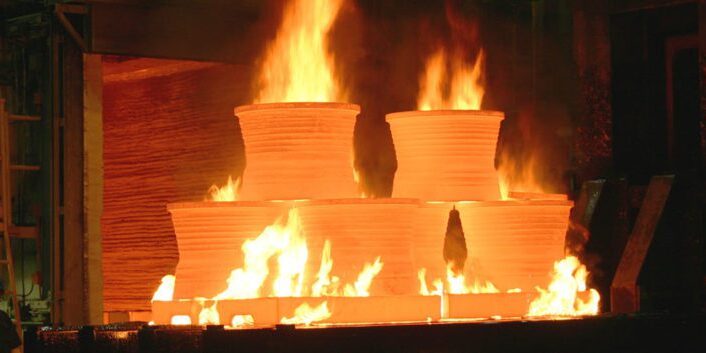Heat Treatment
Technical expertise to give customers material properties they need
MetalTek’s depth of experience in austenitizing, quenching, tempering, and annealing over hundreds of alloy grades help us meet customer specifications. This heat treatment expertise combined with our metallurgy capabilities allows MetalTek to deliver the specific material properties that our customers need.
We offer computer-controlled oil, water, and air quench at multiple locations, with certifications including Nadcap and AMS 2750. Heat treatment capabilities are available up to 2250°F (1232°C) or more in a range of dimensions up to more than 37’ (11 m) in length.
If you have a material properties or performance issue to discuss, talk to a MetalTek metallurgist. MetalTek has the technical capabilities and expertise to satisfy your exact material requirements.
An oil quench performed at MetalTek’s Wisconsin Centrifugal Division.
| Feature | Oil Quenching | Water Quenching | Air Quenching |
|---|---|---|---|
| Primary Application | Hardening steel and other alloys where effective heat extraction and minimal distortion are needed. | Certain alloys and applications where rapid cooling is critical to achieve desired hardness levels. | Specific alloys and applications where lower cooling rates are desirable to develop a fine microstructure without excessive hardening. |
| Cooling Medium | Precisely maintained oil at optimal temperature. | Water with manipulated flow and temperature. | Ambient air or forced air with precise control over airflow and temperature. |
| Key Benefits |
|
|
|
Vacuum Heat Treatment
Heat treating in a high-temperature vacuum furnace prevents adverse effects such as discoloration that occur due to the presence of oxygen. In vacuum heat treatment, air (and oxygen) is removed from the furnace to create a vacuum. The part may be heated in the vacuum with or without an inert gas (typically Argon) to achieve the desired properties while protecting the part’s surface. As in traditional heat treatment, the metal is quickly cooled. Advantages of vacuum heat treatment include improved material strength, high thermal efficiency, and no oxidation, decarburization, or carburization.
MetalTek has a maximum vacuum heat treatment capacity of 31 cubic feet (0.87 cubic meters) and a maximum heating temperature of 2,400°F (1315°C). Typical stainless-steel alloys used in vacuum heat treatment include 17-4 PH, Inconel 625, and MTEK M152.
Advantages of Vacuum Heat Treatment
- Prevention of Oxidation: One of the most significant benefits of this method is its ability to prevent oxidation and other surface degradation issues that can occur when metals are exposed to air during heating. This results in a cleaner surface finish.
- Improved Material Properties: Vacuum heat treatment can enhance mechanical properties such as tensile strength, ductility, and hardness, making it ideal for demanding applications in industries like aerospace, automotive, and medical devices.
- Consistent Quality: The controlled environment leads to more consistent results across batches, reducing variability and ensuring that parts meet strict industry standards.
- Reduction of Contaminants: The absence of atmospheric gases not only protects the surface of the metal but also minimizes contamination from elements that can compromise the metal's performance.
Applications
Vacuum heat treatment is particularly beneficial for materials that require tight tolerances and high performance, such as stainless steels, high-speed steels, and superalloys. Common applications include:
- Aerospace components that demand high strength-to-weight ratios.
- Medical instruments that require precision and durability.
- High-performance automotive parts, such as gears and drive shafts.
In conclusion, vacuum heat treatment offers a cutting-edge solution for achieving optimal material properties while maintaining surface quality. As industries continue to advance, the demand for this technology is expected to rise, making it a vital process for manufacturers aiming to enhance the performance of their products.

